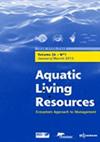西非商业家庭养鱼创新导致生态集约化的案例研究
IF 1.9
4区 农林科学
Q3 FISHERIES
引用次数: 0
摘要
原来的养鱼发展发生在Côte科特迪瓦的中西部和西南部以及几内亚共和国的森林地区。在很少或不投喂的情况下,在坝池中生产的主要种类是尼罗河异源鱼和尼罗河Oreochromis niloticus。这里常种淹水水稻。这些产品供应当地市场。在本文中,我们试图了解导致这些系统的三种实践特征的创新轨迹:“水坝池塘中大量罗非鱼生产,饲料少”,“罗非鱼和异养鱼混养”和“池塘中淹水水稻种植”。然后我们评估了这些创新对生态集约化的贡献。构成当前发展基础的做法是20世纪90年代在家庭农场发展起来的。在某些关键时刻,技术选择的适宜性完全取决于养鱼户,他们根据自己的条件来判断所测试的技术。我们的评估表明,这些农民对生态集约化做出了积极贡献。它们遭受经常性的现金流动问题,因此在其养鱼系统中具有自然资源和生态功能:放养密度以充分利用自然营养资源,通过混养和比传统低地水稻生产效率更高的额外水稻生产加以改善。促进对现有技术的依赖和对当地文化的依赖,加强了对这些系统生态集约化的贡献。分析表明,这种家庭养殖场综合商业养鱼的发展对水产养殖的生态集约化和创新提出了质疑。本文章由计算机程序翻译,如有差异,请以英文原文为准。
Case study of innovations in commercial West African family fish farming that led to an ecological intensification
Original fish-farming developments occur in west-central and south-western Côte d’Ivoire and in the forest area of the Republic of Guinea. Oreochromis niloticus and Heterotis niloticus are the main species produced in dam ponds with little or no feeding. Flooded rice is often grown here. The products supply local markets. In this article, we seek to understand the innovation trajectories that have led to three practices characteristic of these systems: ‘large tilapia production with little feed in dam ponds’, ‘tilapia and Heterotis polyculture’ and ‘flooded rice cultivation in ponds’. We then assess the contribution of these innovations to ecological intensification. The practices that form the basis for current developments were developed in the 1990s on family farms. The suitability of technical choices at certain key moments depended entirely on the fish farmers who judged the tested techniques on their own terms. Our assessment shows that these farmers have contributed positively to ecological intensification. They suffer from recurrent cash flow problems and have thus natural resources and ecological functions in their fish farming system: stocking density to make the best use of the natural trophic resources, improved by polyculture and additional rice production that is more efficient than traditional lowland rice production. The promotion of reliance on existing know-how and anchoring in local culture strengthen the contribution to these systems’ ecological intensification. The analysis shows that this development of integrated commercial fish farming in family farms questions ecological intensification and innovation in aquaculture.
求助全文
通过发布文献求助,成功后即可免费获取论文全文。
去求助
来源期刊

Aquatic Living Resources
农林科学-海洋与淡水生物学
CiteScore
2.30
自引率
0.00%
发文量
10
审稿时长
>24 weeks
期刊介绍:
Aquatic Living Resources publishes original research papers, review articles and propective notes dealing with all exploited (i.e. fished or farmed) living resources in marine, brackish and freshwater environments.
Priority is given to ecosystem-based approaches to the study of fishery and aquaculture social-ecological systems, including biological, ecological, economic and social dimensions.
Research on the development of interdisciplinary methods and tools which can usefully support the design, implementation and evaluation of alternative management strategies for fisheries and/or aquaculture systems at different scales is particularly welcome by the journal. This includes the exploration of scenarios and strategies for the conservation of aquatic biodiversity and research relating to the development of integrated assessment approaches aimed at ensuring sustainable and high quality uses of aquatic living resources.
 求助内容:
求助内容: 应助结果提醒方式:
应助结果提醒方式:


